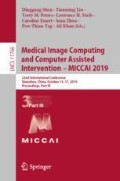Abstract
Discriminative deep learning models have shown remarkable success in many medical image analysis applications. However, their success is limited in problems that involve learning from imbalanced and heterogeneous datasets. Generative models parameterized using deep learning models can resolve this problem by characterizing the distribution of well-represented classes, a step enabling the identification of samples that were improbably generated from that distribution. This paper proposes a semi-supervised out-of-sample detection framework based on a 3D variational autoencoder-based generative adversarial network (VAE-GAN). The proposed framework relies on a high-level similarity metric and invariant representations learned by a semi-supervised discriminator to evaluate the generated images. The encoded latent representations were constrained according to user-defined properties through a jointly trained predictor network. Anomaly samples are detected using learned similarity scores and/or scores from an online one-class neural network. The high performance of the proposed methods is confirmed via a novel application to the automatic quality control of structural MR images.
Access this chapter
Tax calculation will be finalised at checkout
Purchases are for personal use only
References
Litjens, G., et al.: A survey on deep learning in medical image analysis. Med. Image Anal. 42, 60–88 (2017)
Krawczyk, B.: Learning from imbalanced data: open challenges and future directions. Prog. Artif. Intell. 5(4), 221–232 (2016)
Elsayed, G., et al.: Adversarial examples that fool both computer vision and time-limited humans. In: NIPS, pp. 3914–3924 (2018)
Kingma, D.P., et al.: Auto-encoding variational bayes. arXiv preprint (2013)
Lu, Y., et al.: Anomaly detection for skin disease images using variational autoencoder. arXiv preprint (2018)
Vasilev, A., et al.: q-space novelty detection with variational autoencoders. arXiv preprint (2018)
El Azami, M., et al.: Detection of lesions underlying intractable epilepsy on T1-weighted mri as an outlier detection problem. PLoS ONE 11(9), e0161498 (2016)
Goodfellow, I., et al.: Generative adversarial nets. In: Advances in Neural Information Processing Systems, pp. 2672–2680 (2014)
Schlegl, T., Seeböck, P., Waldstein, S.M., Schmidt-Erfurth, U., Langs, G.: Unsupervised anomaly detection with generative adversarial networks to guide marker discovery. In: Niethammer, M., et al. (eds.) IPMI 2017. LNCS, vol. 10265, pp. 146–157. Springer, Cham (2017). https://doi.org/10.1007/978-3-319-59050-9_12
Chen, X., Konukoglu, E.: Unsupervised detection of lesions in brain MRI using constrained adversarial auto-encoders. arXiv preprint (2018)
Makhzani, A., et al.: Adversarial autoencoders. arXiv preprint (2015)
Baur, C., Wiestler, B., Albarqouni, S., Navab, N.: Deep autoencoding models for unsupervised anomaly segmentation in brain MR images. In: Crimi, A., Bakas, S., Kuijf, H., Keyvan, F., Reyes, M., van Walsum, T. (eds.) BrainLes 2018. LNCS, vol. 11383, pp. 161–169. Springer, Cham (2019). https://doi.org/10.1007/978-3-030-11723-8_16
Larsen, A.B.L., et al.: Autoencoding beyond pixels using a learned similarity metric. arXiv preprint (2015)
Scholköpf, B., et al.: Support Vector Machines, Regularization, Optimization, and Beyond. Learning with Kernels (2002)
Chalapathy, R., et al.: Anomaly detection using one-class neural networks. arXiv preprint (2018)
Howell, B.R., et al.: The UNC/UMN baby connectome project (BCP): an overview of the study design and protocol development. NeuroImage 185, 891–905 (2019)
Jha, S.C., et al.: Genetic influences on neonatal cortical thickness and surface area. Hum. Brain Mapp. 39(12), 4998–5013 (2018)
Blumenthal, J.D., et al.: Motion artifact in magnetic resonance imaging: implications for automated analysis. Neuroimage 16(1), 89–92 (2002)
Radford, A., et al.: Unsupervised representation learning with deep convolutional generative adversarial networks. arXiv preprint (2015)
McInnes, L., et al.: UMAP: uniform manifold approximation and projection for dimension reduction. arXiv preprint (2018)
Author information
Authors and Affiliations
Corresponding author
Editor information
Editors and Affiliations
1 Electronic supplementary material
Below is the link to the electronic supplementary material.
Rights and permissions
Copyright information
© 2019 Springer Nature Switzerland AG
About this paper
Cite this paper
Mostapha, M. et al. (2019). Semi-supervised VAE-GAN for Out-of-Sample Detection Applied to MRI Quality Control. In: Shen, D., et al. Medical Image Computing and Computer Assisted Intervention – MICCAI 2019. MICCAI 2019. Lecture Notes in Computer Science(), vol 11766. Springer, Cham. https://doi.org/10.1007/978-3-030-32248-9_15
Download citation
DOI: https://doi.org/10.1007/978-3-030-32248-9_15
Published:
Publisher Name: Springer, Cham
Print ISBN: 978-3-030-32247-2
Online ISBN: 978-3-030-32248-9
eBook Packages: Computer ScienceComputer Science (R0)


